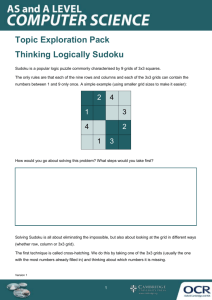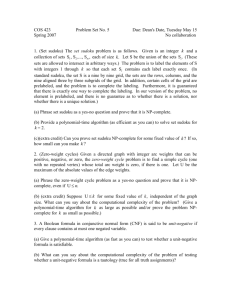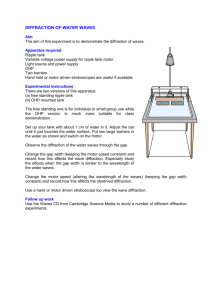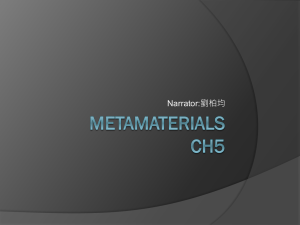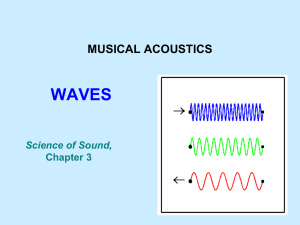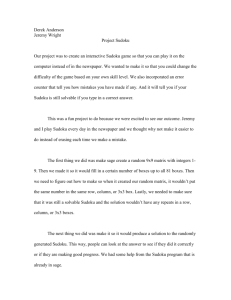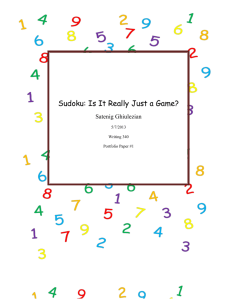Sudoku Project Report
advertisement
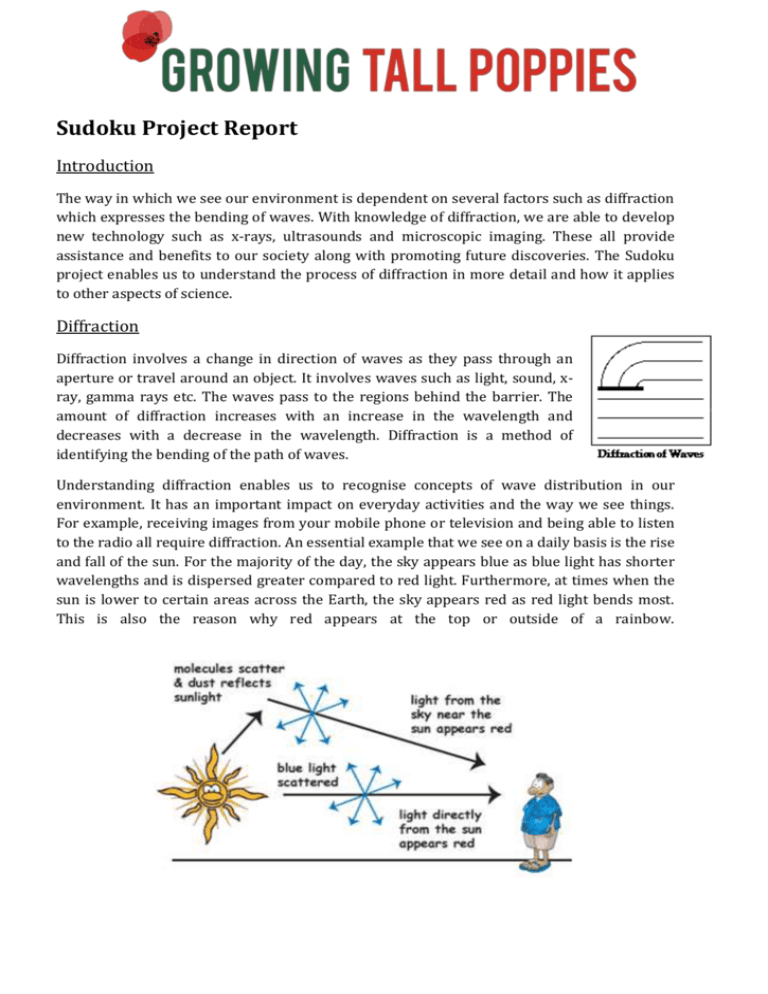
Sudoku Project Report Introduction The way in which we see our environment is dependent on several factors such as diffraction which expresses the bending of waves. With knowledge of diffraction, we are able to develop new technology such as x-rays, ultrasounds and microscopic imaging. These all provide assistance and benefits to our society along with promoting future discoveries. The Sudoku project enables us to understand the process of diffraction in more detail and how it applies to other aspects of science. Diffraction Diffraction involves a change in direction of waves as they pass through an aperture or travel around an object. It involves waves such as light, sound, xray, gamma rays etc. The waves pass to the regions behind the barrier. The amount of diffraction increases with an increase in the wavelength and decreases with a decrease in the wavelength. Diffraction is a method of identifying the bending of the path of waves. Understanding diffraction enables us to recognise concepts of wave distribution in our environment. It has an important impact on everyday activities and the way we see things. For example, receiving images from your mobile phone or television and being able to listen to the radio all require diffraction. An essential example that we see on a daily basis is the rise and fall of the sun. For the majority of the day, the sky appears blue as blue light has shorter wavelengths and is dispersed greater compared to red light. Furthermore, at times when the sun is lower to certain areas across the Earth, the sky appears red as red light bends most. This is also the reason why red appears at the top or outside of a rainbow. Electromagnetic spectrum The electromagnetic spectrum displays the range of waves and frequencies that are present in our environment. The spectrum places different types of waves dependent on the length of them. As we can see, Gamma rays have the shortest wave length and the highest frequency however radio waves have the longest length and the shortest frequency. Amongst this spectrum, visible light is shown. The colours red to violet are visible to the naked eye. All of these waves are individually beneficial to certain aspect of life and have both positive and negative results. Visible Light Visible light displays the colours red to violet as shown in the rainbow. Each colour has different wave lengths which determine the angle that they bend and how they are viewed. For instance, red light has a longer wave length and violet has a shorter wave length. In order for an object’s colour to be visible it has to absorb every colour apart from the one it is willing to reflect. White light White is not a colour at all; however it is made up of all the colours of visible light. The three primary colours of white light are red, green and blue. These combined with varying degrees of intensities can emit a range of colours. Sudoku Project Aim When completing this project, our aim was to produce a Sudoku game board that exhibits and replicates the process involved in explaining diffraction situations. The method through which the Sudoku problem was solved was the iteration method. Through doing this, we discovered applications of this method and how it relates to other problem solving aspects of science. The process of solving the game had the aim to educate us in relation to the method through which scientists solve diffraction data and identify colours and shapes based on biological molecules. The motivation through which we completed this project enabled us to investigate a scientific topic in a much more interactive format. By understanding the knowledge required we will be able to select a career pathway that best expresses our interests. Method To prove the relationship between diffraction/x-ray imaging and the Sudoku project we worked through a set of Sudoku puzzles using the iteration method. The iteration method states that we have to work through the puzzle following a set of instructions that we apply repeatedly until solved. 1) Access an unsolved Sudoku puzzle and set out on provided board by turning all fixed numbers onto the white side of the piece 2) Begin to solve the puzzle across the columns from left to right, following the Sudoku rule of numbers 1-9 without repetition 3) Ignore previous columns and continue to solve puzzle 4) Once finished all columns, begin solving first row on puzzle 5) Continue solving rows, ignoring previous one, until reached last row 6) Revisit columns and continue to solve one at a time 7) Once completed 1-2 cycles, instead of ignoring previous rows/columns, take them into consideration and continue to solve always referring back to them 8) Repeat this method for rows 9) Continue to repeat the process until the puzzle has eventually been solved Whilst this process takes longer than completing Sudoku normally, this technique is useful for other situation in scientific research as it provides a strategic method that always works. It enables you to consider all constraints and work around the data that is present to formulate a reliable outcome. Application There are several instances where this method used in the Sudoku project is applicable. The applications can be further developed to enhance the outcome. They are able to provide a skeletal image which combined with research, can create an understanding of structure. Examples of these applications include: Enigma Code The enigma code was used by the enigma machine which was used in the 20th century for deciphering secret messages. This form of coding was adopted by the military in periods of war. The enigma code was an operation in which a different letter would be selected through pseudo-random substitution. The Sudoku process is similar to this as the same strategic method is used to find a solution and decode an answer based on existing information. DNA (Deoxyribonucleic acid) DNA has the purpose of carrying out genetic instructions in order for cells to function. Its structure is identified through coherent (single wavelength) x-ray imaging in which light reflects the DNA structure. This related to the Sudoku project and iteration method through the use of strategic thinking and techniques. Hologram Coherent x-ray imaging diagram A hologram is a photographic representation of a field of light in third dimension. This is obtained by the use of multiple optic lenses and is viewed by diffused ambient light. It encodes the light field as the pattern of interference change variations. In pure form, holograms require lasers to illuminate the object in perspective. This relates to the Sudoku project as it is solved using a set of constraints and follows a pattern. Conclusion In conclusion, we discovered that the method of iteration used whilst completing the Sudoku project was difficult and time consuming although provided us with an accurate resolution each time. This expressed the diffraction process and enabled us to understand the steps involved in order to revisit the problem and come to a suitable solution based on the existing information provided.The method we learned from completing this project enables us to widen our perceptive of diffraction and the environment around us as well as allowing us to become better problem solvers. This will help us in the future with research tasks and will provide us with the knowledge necessary for analysing and interpreting data.
